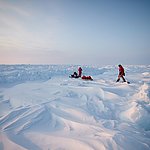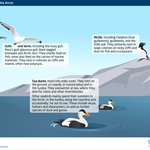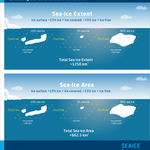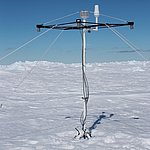Glossary
The English version of our glossary is currently under construction and will be regularly updated.
- A(31)
- B(17)
- C(44)
- D(20)
- E(30)
- F(18)
- G(15)
- H(10)
- I(27)
- J
- K(4)
- L(9)
- M(16)
- N(6)
- O(13)
- P(36)
- Q
- R(14)
- S(45)
- T(23)
- U(5)
- V
- W(3)
- X
- Y(1)
- Z(1)
- 0(2)
Salinity
Salinity of water or soil. Represents the amount of dissolved salt in water.
moreSAR
The IPCC’s Second Assessment Report.
moreSastrugi
Sastrugi are rippling grooves or ridges in the snow.
more
SCAR
The Scientific Committee for Antarctic Research is a non-governmental organisation and was founded in 1958.
moreScenario
Scenarios are based on a range of assumptions concerning global developments like population growth, economic and social trends, technological advances, resource consumption and environmental management.
moreSea ice
The totality of ice found on and in the ocean.
more
Sea surface temperature
The sea surface temperature is the mean temperature in the near-surface metres of the ocean.
moreSea-ice avifauna
The sea-ice avifauna are the birds of the sea ice.
more
Sea-ice cover
The sea-ice cover has been determined on the basis of satellite data for over 30 years. As a rule, presented as the “sea-ice extent”, as the “sea-ice area” in square kilometres, or as the “sea-ice concentration”.
more
Sea-level change
The height of the ocean’s surface. It approximates an equipotential surface of the Earth’s gravitational field. When it changes, it is referred to as sea-level change.
moreSecondary consumers
Organisms in a given ecosystem that, at the 3rd level of the food pyramid, heterotrophically live off of primary consumers, e.g. fish that feed on zooplankton.
moreSecondary production
In ecology, the production of biomass or energy at the level of consumers and decomposers.
moreSediment core
A sample that is collected by vertical drilling into sea sediment or sediment from inland water bodies.
moreSequestration
CO2 sequestration refers to the storage of carbon dioxide (CO2) deep underground.
moreShelf sea
Shallow waters on the edge of a continent and extending from a coast to a shelf edge, which can lie up to 200 metres below the surface. Shelf seas are typically several tens of kilometres to a few hundred kilometres wide and offer vital habitat for marine organisms. They are also important resources for the fishing industry and oil and gas exploration.
moreShore lead
A lead between drifting ice and the shore or between drifting ice and an ice front.
moreShuga
A collection of spongy white ice clumps measuring a few centimetres wide.
moreSingle-ping reading
A single-ping reading refers to the practice of gathering data with scientific instruments and using just one signal or “ping”. Single-ping readings are typically used in order to capture short-term impulses, whereas continuous readings are taken over extended timeframes. In hydrology and oceanography, Acoustic Doppler Current Profilers (ADCPs) are often used to take single-ping readings of the flow speed, direction and turbulence in a river or ocean.
moreSink
Any process, mechanism or activity that absorbs a greenhouse gas, aerosol, or a precursor of a greenhouse gas or aerosol, thus removing it from the atmosphere.
moreSlush
Snow that is saturated with water and lies on the land or ice; or a soupy clump of floating ice formed in the cooled water after heavy snowfall.
moreSnow buoy
Since 2012, snow buoys have been used to measure snow thickness, atmospheric temperature and pressure over the sea ice.
more
Snow stratigraphy
Scientific investigation and description of layer formation in snow cover. In this regard, properties like snow depth, snow crystal forms, grain size, and density are assessed and recorded in order to draw conclusions regarding the temporal progression and spatial distribution of changes in the snow cover. Snow stratigraphy is especially important for climate research and for gauging the risk of avalanches.
moreSnow-ice
Ice with a uniform grain size, which is created when grease ice / slush freezes completely.
moreSolar activity
Changes in the sun’s properties, which are connected to turbulence in its extremely hot gas and constant changes in its magnetic field, are referred to as solar activity. The changes can be cyclical or irregular.
moreSolar cycle (“11-year cycle”)
The solar cycle or sunspot cycle refers to periodicity in the frequency of sunspots. It describes a period of eleven years on average, which is also referred to as the Schwabe cycle in honour of Samuel Heinrich Schwabe.
moreSolar radiation
Electromagnetic radiation emitted by the sun.
moreSoot
Soot particles are chiefly formed during the incomplete combustion of fossil fuels and biomass.
moreSource
Any process, mechanism or activity that releases a greenhouse gas, aerosol, or a precursor of a greenhouse gas or aerosol into the atmosphere.
moreSouthern Oscillation
The Southern Oscillation is a periodic variation (every three to five years) in air surface pressure between the tropical western Pacific and southeast Pacific, which produces effects on wind systems and ocean surface currents.
moreSpatial and temporal scales
The climate can vary over a broad spectrum of spatial and temporal scales. Spatial scales range from local (less than 100,000 km2) to regional (100,000 to 10 million km2) to continental (10 to 100 million km2). Temporal scales can range from seasonal to geological (hundreds of millions of years).
moreSPM
(IPCC) Summary for Policymakers.
moreSRCCS
(IPCC) Special Report on Carbon Capture and Storage. (Special Report on Carbon Capture and Storage)
moreSRES
(IPCC) Special Report on Emission Scenarios. (Special Report on Emission Scenarios)
moreSRES scenario
An emissions scenario for the IPCC’s Third and Fourth Assessment Reports (2001 and 2007).
moreSROC
(IPCC) Special Report on Ocean and Cryosphere in a Changing Climate (2019). (Special Report on Ocean and Cryosphere in a Changing Climate)
moreStabilisation
Maintaining a constant atmospheric concentration of one or more greenhouse gases.
moreStorm tracks
Main tracks of extratropical disruptions, which manifest as sequences of high- and low-pressure cells.
moreStrand community
Refers to algal chains that grow downward from the ice in long strands.
moreStratosphere
Highly stratified atmospheric layer located above the troposphere at between ca. 10 and 50 km above the Earth’s surface.
moreStream gauge
A device or system installed in a coastal location (and in some cases, in the deep sea) that constantly measures the water level surface elevation in relation to the surrounding land. The mean value over time for these surface elevation readings is the observed relative sea-level change.
moreSublimation
The direct transition of a solid into a gas.
moreSubtropical gyre
Ring-shaped system of wind-driven ocean currents. Rotates clockwise in the Northern Hemisphere and counter-clockwise in the Southern Hemisphere.
moreSulphur hexafluoride (SF6)
One of the six greenhouse gases that the Kyoto Protocol calls for combating.
moreSustainable development
Stems from the concept of a sustainable society and the management of renewable resources. Combines political, societal, economic and environmental aspects.
moreSympagic
“Sympagic” is an adjective used to describe an ecosystem found in regions with ice and snow. It refers to the communities of organisms whose lives are closely connected to sea ice or glacier ice.
more